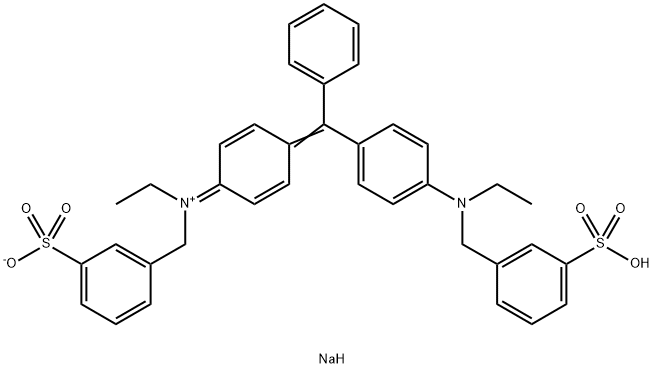Chemical Properties
Green powder
Uses
Limited use as a dye for silk and wool fabrics; as biological stain.
Uses
Guinea Green B has been used as a pharmacophore compound to study its inhibitory action on papillomavirus type 16 E6 protein.
Preparation
Benzaldehyde (1 Moore) and 3-(Ethyl(phenyl)amino)methyl)benzenesulfonic acid (2 Moore) condensation, will product oxidation, and then translate into sodium salt.
Definition
ChEBI: An organic sodium salt having 3-[(ethyl{4-[(4-{ethyl[(3-sulfonatophenyl)methyl]amino}phenyl)(phenyl)methylidene]cyclohexa-2,5-dien-1-ylidene}azaniumyl)methyl]benzene-1-sulfonate. Used as a substitute for Light green SF yellowish in Masson's trichrome, alth
ugh it is prone to fade. Previously used as a food dye but is now no longer approved.
General Description
A dull dark green powder. Used as a dye for silk or wool and biological stains.
Air & Water Reactions
Very soluble in water. Forms a green solution, which becomes brownish-yellow by addition of HCl, and blackish-green with NaOH.
Reactivity Profile
ACID GREEN 3 neutralizes acids in exothermic reactions to form salts plus water. May be incompatible with isocyanates, halogenated organics, peroxides, phenols (acidic), epoxides, anhydrides, and acid halides. May generate hydrogen, a flammable gas, in combination with strong reducing agents such as hydrides.
Properties and Applications
bright green. Soluble in water for the green, soluble in ethanol for blue light green. The strong sulfuric acid for lemon yellow, diluted to green. The dye solution is to join sodium hydroxide to colorless.
|
Standard
|
Light Fastness
|
Soaping
|
Persperation Fastness
|
Oxygen bleaching
|
Fastness to seawater
|
|
Fading
|
Stain
|
Fading
|
Stain
|
Fading
|
Stain
|
|
ISO
|
2
|
1
|
3
|
3
|
1
|
|
3
|
|
|
AATCC
|
2
|
1
|
1
|
3
|
1
|
|
5
|
|


